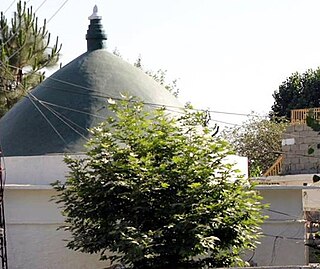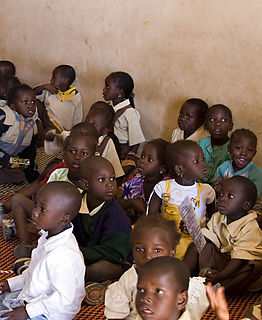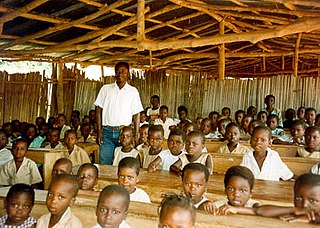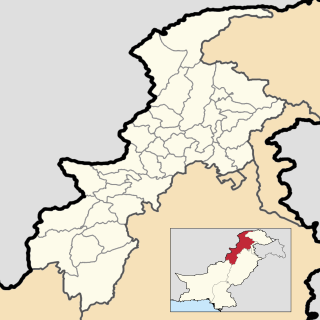This article needs additional citations for verification .(April 2007) (Learn how and when to remove this template message) |
Education in Lower Dir District in Pakistan.
This article needs additional citations for verification .(April 2007) (Learn how and when to remove this template message) |
Education in Lower Dir District in Pakistan.
The total gross enrollment ratio is 73.83% [1] without including Kachi and 79.59% including Kachi class. Student teacher ratio is 43 students per teacher and there are 41 boys per male teacher and 46 girls per female teacher.
According to the recent Universal Primary Education (UPE) survey, the total number of children in the age group 5–7 years is 104,498 [2] in which 56,937 [2] are boys and 47,561 are girls. Due to the limited access the number of the out of school children among the age group (5–7 years) are 25,169, [2] almost 24% children of the total (age group 5–7 years) are out of the school. In which 19% are boys and 30% are girls. These figures also include the dropped out students both boys and girls.
There are 1,023 [3] villages in district Dir lower. There are:
Beside the government primary schools, Khwendo Kor NGO is running 15 schools, Elementary Education Foundation (EEF) is running 25 schools, ILO is running 7 schools and Non Formal Basic Education (NFBE) is running 95 schools. The numbers of madrassas (religious schools) are not yet available.
The adult literacy of the district among the population aged 10 years and above is 93.9% which has increased significantly since 1981 when it was just 10.16 percent. The male literacy ratio is 95.76%> compared to 85.25% percent for females, according to census report 2018. [5]
The term quality Education needs clarity and no such practices are observed in the schools. The PTAs are formed in the schools according to government procedures, but these are only limited to school petty repairs and not involved in the school management.
In District Dir the schools and literacy department is supported by the World Food Programme for a girls enrollment enhancement programme. They provide the edible oil to the girls enrolled in the low enrollment school. There is need of developing more partnerships among these stakeholders so that the problems of education especially in the female education are solved.
The NGO Khwendo Kor (KK) started a project on “Promotion of Girls Education in Dir” in this project KK strengthened and transformed the VECs (Village Education Committees) formed around the Community Based Girl Schools. The PRAs (Participatory Rural Appraisal) was carried out in 25 villages. Other activities running in District Dir are Women and Men Organization formation, the capacity building of the women organization and men organization was made in social activist, record keeping, PRAs, financial management etc.
KK has now initiated a project on female education in Dir. This project is the combination of some activities, like the Development of District Education Planning, reactivating, strengthening and capacity building of PTAs, EFA forum activation and strengthening, educational budget tracking and Education Facilitation Center establishment, functionalization of the middle and primary schools. KK will facilitate the PTAs to register themselves as CCB with district government and get extra funds from the district development budget. This project will strengthen the public private partnership in education sector. KK has already signed the MoU with School and Literacy Department for undertaking these activities. CRC (SPARC) Child rights committee for Lower Dir district has also focused recently on the Education ratio in Lower Dir. CRC is a voluntary organization of SPARC working for the children rights in Lower Dir by means of lobbying and advocacy. CRC has now started a campaign against child marriage. Child marriage is also one of those harmful traditional practices which has been declared a criminal offence by the Child Marriage Restraint act 1929, yet they are being held with impunity throughout KPK, where the tradition has stronger roots than law.
According to the EMIS] of the School and literacy department, schools have different problems like drinking water supply, boundary walls, electricity and latrines. After devolution plan improvements are still awaited and the involvement of elected representatives in the monitoring and problem solving will take time. The role of CCBs in the education and schools is not explored and it can give better results if they are engaged in the education.

Jango is a village in Lower Dir District of Khyber-Pakhtunkhwa. It is located at 34°43'45N 72°2'60E and lies on the main Chakdara-Asbanr road, it has a population of about 3000. This village has been gradually merging with another village named Tazagram which is located near it. Jango village is the part of Union Council Tazagram. The literacy ratio in this village has climbed high in recent years, as it has been located in Dir District, known as a backward area in Pakistan. The population under 30 and above 10 has a literacy rate of over 80% which is a significant improvement from the 5% recorded in the 1970s. The village has produced highly qualified professionals in fields of Education, Sciences, Law and Engineering. People of Jango also gives high place to religion and their beloved country Pakistan. Brave sons of this village have given sacrifices in Afghanistan and Kashmir for the noble cause of Islam and Pakistan.

The system of education in Uganda has a structure of 7 years of primary education, 6 years of secondary education, and 3 to 5 years of post-secondary education, according to Education News Uganda The government of Uganda recognizes education as a basic human right and continues to strive to provide free primary education to all children in the country. However, issues with funding, teacher training, rural populations, and inadequate facilities continue to hinder the progress of educational development in Uganda. Girls in Uganda are disproportionately discriminated against in terms of education; they face harsher barriers when trying to gain an education and it has left the female population disenfranchised, despite government efforts to close the gap.

Lower River Division is one of the five administrative divisions of the Gambia. Its capital is Mansa Konko. The city and area council elections were held during April 2002, when Wally S.M. Sanneh, an APRC candidate became the Mayor, winning unopposed. The council was led by Alliance for Patriotic Reorientation and Construction (APRC), which won all the 12 seats.

North Bank was one of the five administrative divisions of the Gambia. Its capital was Kerewan. It was subsequently reorganised as the Kerewan Local Government Area (LGA), without any change in the area covered.

Chakdara is a town in Lower Dir District of Khyber-Pakhtunkhwa in Pakistan. Located north of Malakand near the confluence of the Swat River with the Panjkora River, in a commanding position near the entrance to Swat District and at the entrance to Lower Dir. It is about 130 km (81 mi) from Peshawar and 40 km (25 mi) away from Mingora.

Dir is a region in northwestern Pakistan, in the Khyber Pakhtunkhwa. It is located in the foothills of the Himalayas. Before Pakistan was created, Dir was a princely state, and it remained so until 1969 when it was abolished by a presidential declaration, with the Dir District being created the following year. Dir District was 5,280 square kilometres in area and lay along the disputed border controlled by the Afghan nationalists. The region is situated between Chitral and Peshawar. In 1996 the district was split into Lower Dir and Upper Dir.

Timergara is the district headquarters of Lower Dir District in Pakistan. Timergara City is located on the east bank of the Panjkora River. It lies at an altitude of 823 metres (2,700 ft). The town is the site of excavated graves of Indo-Aryans, dating from 1500 to 600 BC. On the west side of the Panjkora River is the excavated site of Balambat. The site has been occupied continuously since the time of the Indo-Aryans in 1500 BC. Discoveries included houses dating from 500 BC and fire altars, showing that the people followed early Vedic Hinduism which revolved around fire worshipping. The areas early political history is defined by the control of the Hindu Shahis, artifacts and ruins from the period is found throughout the region. At the 1998 Census, the town had a population of 43,774. Most of the main city lies on the bank of the river Panjkora, which separates Balambat from the main city.

The Constitution mandates free and compulsory primary education in the Gambia, but a lack of resources and education infrastructure has made implementation difficult. In 1995, the gross primary enrollment rate was 77.1 percent and the net primary enrollment rate was 64.7 percent. School fees long prevented many children from attending school, but in February 1998 the president of the Gambia ordered the termination of fees for the first six years of schooling. Girls make up about 40 percent of primary school students, though the figure is much lower in rural areas where cultural factors and poverty prevent parents from sending girls to school. Approximately 20 percent of school-age children attend Koranic schools, which usually have a restricted curriculum.

In 2005, the literacy rate in Laos was estimated to be 73%.

Badwan (Urdu: باڈوان) is a Union Council, situated on the bank of River Swat at an altitude of 2192 feet. It is a part of Adenzai Tehsil of Lower Dir District, Khyber-Pakhtunkhwa. It contains many small villages including Badwan Upper, Badwan Lower, Badwan Khambo, Shamlai, Baghkandi, Ramyal, Othar, Safrona, Gadar, Barorri, Leko, Ghwando, Torogato, Swato Banda, Ghazo etc. Its population is approximately 25,000. In the past Badwan was a part of a union council known as Khadagzai Abazai which comprised Badwan, Brangola and Khadagzai. But now Badwan is a separate union council.

Benin has abolished school fees and is carrying out the recommendations of its 2007 Educational Forum. In 1996, the gross primary enrollment rate was 72.5 percent, and the net primary enrollment rate was 59.3 percent. A far greater percentage of boys are enrolled in school than girls: In 1996, the gross primary enrollment rate for boys was 88.4 percent as opposed to 55.7 percent for girls. The net primary enrollment rates were 71.6 percent for boys and 46.2 percent for girls. Primary school attendance rates were unavailable for Benin as of 2001.

Education in Sierra Leone is legally required for all children for six years at primary level and three years in junior secondary education, but a shortage of schools and teachers has made implementation impossible. The Sierra Leone Civil War resulted in the destruction of 1,270 primary schools and in 2001 67 percent of all school-age children were out of school. The situation has improved considerably since then with primary school enrollment doubling between 2001 and 2005 and the reconstruction of many schools since the end of the war. However, there is still a long ways to go. In 2004, Junior secondary school enrollment was only 17% of primary school enrollment, and senior secondary school enrollment was only 8% of primary school education.

Baroon is a village in Lower Dir district of Pakistan, situated at a distance of about 11 km from Timergara, on the way from Timergara to Upper Dir, opposite to the main road, separated from the main road by Panjkora river. The village contains many beautiful fields in which different crops are sown like rice, wheat, maize, different vegetables, however the massive flooding in 2010 affected the fields. Although most of the fruits gardens were swept away by the severe flood, still some fruits like Persimmon and Orange can be seen at some spots.
Ramyal is a small village in Lower Dir District, Malakand region of Khyber-Pakhtunkhwa, Pakistan. Ramyal is located to on the west of Chakdara. The village is 3 km away from Chakdara city, which is located near Churchill Piquet on the bank of the Swat River. The population of Ramyal is about 2,000 and consists of primarily of Pashtun speaking the Pashto language. ramyal has one primary school for boys and girls respectively,according to Indian military gauzatier 1897 ramyal is very old village and a narrow footpath leading from chakdara to burchary hill at that time a dozen houses were in ramyal.
Kityari is a village located in Lower Dir District, Khyber-Pakhtunkhwa. Kityari is located on the road between Chakdara and Asbanr near Shaban. The village is 12 km away from Chakdara city, which is located near Churchill Piquet on the banks of the Swat River. The population of Kityari is about 5000 and consists of primarily Pashtun people speaking the Pashto language
Women's education in Pakistan is a fundamental right of every female citizen, according to article thirty-seven of the Constitution of Pakistan, but gender discrepancies still exist in the educational sector. According to the 2011 Human Development Report of the United Nations Development Program, approximately twice as many males as females receive a secondary education in Pakistan, and public expenditures on education amount to only 2.7% of the GDP of the country.
Ouch is a town in Lower Dir District, Khyber Pakhtunkhwa, Pakistan. The town has seen extensive expansion and enjoys good communication as it is located on the main N45 Dir Road, about 10 kilometres (6.2 mi) north of Chakdara. The region is about 138 km (86 mi) away from Peshawar and 48 km (30 mi) away from Saidu Sharif and is mainly known for its shoemakers and gold-sellers.
Munda is an administrative subdivision (Tehsil) of Lower Dir District in the Khyber Pakhtunkhwa province of Pakistan. Munda is an administrative Tehsil under the jurisdiction of Samar Bagh, sub-division of Lower Dir District.

Bagh Dushkhel is a union council in Lower Dir District, Khyber Pakhtunkhwa, Pakistan.

Osakai is a village in Lower Dir District of the Khyber Pakhtunkhwa province of Pakistan. Osakai is divided into Osakai Bala and Osakai Payeen. It comes under Union Council Kotigram and under Tehsil Adenzai. Osakai as a whole consist of karim abad, Dage, Ghwande, Bar kalay and Lowara. Osakai has a hospital unit (BHU), Govt high school for Girls and also a government high school for boys. osakai has some historical places i.e kafir kot, sroo manroo and also have many picnic spots i.e osakai waterfall, khan baba, bar charay, small water dams. osakai is famous for stone slab it can use for grave and sevrage system . Tribes in osakai. Sarkani Khail, roghani, uthman khail, tajak degaan, shinwari, sadaat, wardag and babakhail.